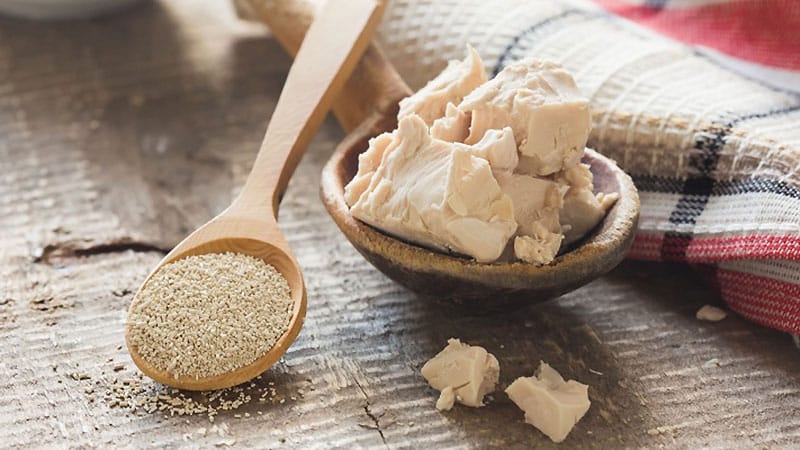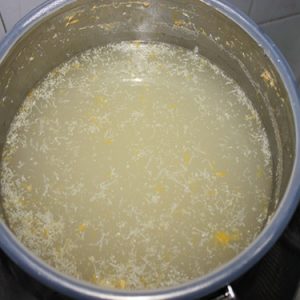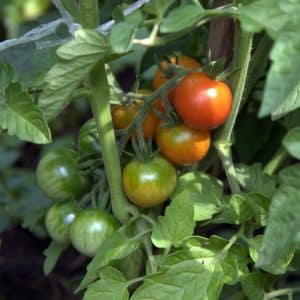Secrets of proper care for tomatoes: how to feed tomatoes with yeast in a greenhouse and what it will give
It is possible to grow tomatoes without using chemicals! Yeast is a product familiar to many housewives, but it has also found application in the garden. Not only the dough, but also the plants grow with yeast. How to feed tomatoes with yeast in a greenhouse, and what to do if you have exceeded the dosage and the soil has fermented - you will learn all this from our article.
Action and effectiveness of yeast
Baker's yeast, which belongs to the group of unicellular fungi, is the best budgetary means for feeding nightshades. The product contains proteins, amino acids and vitamins. When released into the soil, active yeast compounds begin to interact with local microorganisms, which allows the release of nutrients. In particular, the soil is enriched with nitrogen and phosphorus. Yeasts also inhibit pathogenic microorganisms.
It is no secret that many problems in the development of nightshades occur due to a lack of nutrients. Summer residents learned about the benefits of yeast in the garden back in the 1970s. However, later this remedy was no longer used due to the appearance of chemicals on the market. Now many vegetable growers are returning to past experience in order to grow the most environmentally friendly product possible.
Benefits of using yeast
The effect of yeast on the plant is similar to the effect of preparations of effective microorganisms:
- rapid absorption of nutrients by the plant;
- active development of roots and above-ground parts of the plant;
- increase in the number of ovaries and fruits;
- increasing resistance to diseases, pests and temperature changes;
- quick adaptation after a dive;
- improvement of soil properties - enrichment with phosphorus and nitrogen;
- ease of diluting the solution and maintaining proportions.

Peculiarity. The product is suitable for feeding carrots, cucumbers, peppers, flowers and garden shrubs. However, it is not recommended to fertilize garlic, onions and potatoes with the product.
Lack of yeast nutrition
Experts agree that the product stimulates root growth well and is a good alternative to many expensive EM preparations. However, due to the high activity of bacteria, potassium and calcium are quickly washed out of the soil. For yeast to work, there must be sufficient organic compounds in the soil.
Frequent use of yeast in the garden can result in soil that is rocky, difficult to work, and organically poor.
This problem can be solved using the following methods:
- Before planting, add organic fertilizers to the soil.
- To protect against leaching of useful elements, use wood ash. If a pure yeast solution was used, then the next day it is necessary to scatter the ash on the beds.
- Fertilize well-warmed soil.
Reaction of tomatoes to yeast
The yeast solution is suitable for treating both seedlings and adults plants grown in greenhouses. The rich content of useful elements allows plants to gain strength faster and resist diseases.
Yeast allows you to get a rich harvest. The plant blooms and bears fruit wildly. Tomatoes grow large, fleshy and juicy.
Feeding seedlings
Seedlings grown at home often suffer from a lack of sunlight, which weakens their root system. Fertilizing with yeast allows strong roots to form several weeks earlier than untreated nightshades.
Natural fertilizer acts on seedlings so that they begin to grow in breadth rather than upward. It also helps to increase the stability of the plant, which means it will more easily tolerate planting in the ground.
To process seedlings, make the following solution: 10 g of dry yeast, 2 tbsp. l. Mix sugar and 10 liters of warm water and leave for several hours. The concentrate is diluted with water in a ratio of 1:5.
A few days after treatment, the seedlings noticeably increase in size, the leaves thicken and acquire a rich color.
Feeding tomatoes in a greenhouse
To obtain a rich harvest in the greenhouse, you need to provide optimal conditions: maintain a balance of humidity, temperature and lighting. Watering is also important, as well as timely fertilization of plants - violation of these rules will lead to inhibition of plant development and impoverishment of ovaries. Yeast feeding allows tomatoes to actively develop.
The basic rule for growing nightshades in a greenhouse is to prepare the soil before planting seedlings. The best natural fertilizers are compost and manure, per 1 sq. m area you will need a bucket of fertilizer. As soon as the plants have been planted, they must be mulched with straw. Then the tomatoes only need yeast feeding; no other fertilizers are needed.
When and how to feed tomatoes
 The first fertilizing with yeast is carried out a week after planting the seedlings; 0.5 liters of solution is enough for one bush. The procedure is repeated after the tomatoes have taken root well and the first two or three leaves have appeared - you will need 1 liter of mixture per bush. The tomatoes can be treated for the third time shortly before the flowering period - 2 liters of solution per plant.
The first fertilizing with yeast is carried out a week after planting the seedlings; 0.5 liters of solution is enough for one bush. The procedure is repeated after the tomatoes have taken root well and the first two or three leaves have appeared - you will need 1 liter of mixture per bush. The tomatoes can be treated for the third time shortly before the flowering period - 2 liters of solution per plant.
To treat seedlings, use the following solution: 100 g of wet yeast is mixed with 1 liter of warm water, after a couple of hours the concentrate is diluted with water so that its volume is 10 liters. If there are few bushes, then you can take fewer ingredients - dilute 10 g of yeast in 100 g of water, the total volume of the solution should be 1 liter.
Important! The prepared solution must be used on the same day. Do not feed seedlings with fermented mixture!
The solution is carefully poured under the root of the plant. It is better to water the plants in the morning or evening in calm weather.
For the second procedure, you can make a solution that uses fermented yeast. The older the plants, the longer the concentrate needs to sit. 1 kg of wet yeast is dissolved in 5 liters of warm water. A couple of days after the smell of fermentation appears, the solution is diluted with water at room temperature in a ratio of 1:10. 0.5 liters of fertilizer is enough for one bush.
In addition to application at the root, yeast is used to water plants before flowering. During the procedure, you need to carefully process the stem and leaf on both sides. To do this, it is better to use a watering can with a diffuser. The procedure cannot be carried out during the daytime, as direct sunlight will evaporate the moisture.
Yeast starter recipes
The cost of fertilizers based on baker's yeast is much lower than chemicals. Both dry and wet products are suitable for the garden. If you have a lot of beds, choose wet yeast, it is used more economically.
Important! You cannot prepare fertilizer for tomatoes from expired yeast.
There are several ways to prepare tomato fertilizer based on baker's yeast.
Sugar-yeast

3 liters of warm water, 100 g of wet yeast, 100 g of sugar. All components are mixed, after which the container is covered with a lid and set aside in a warm place. Before feeding, 200 g of concentrate is diluted with 10 liters of water; one bush will require 1 liter of liquid.
It is good to use wet yeast for fertilizer, but if you have a dry equivalent on hand, you can use it. 10 g yeast and 2 tbsp. l. sugar is diluted in 10 liters of warm water. After the mixture has settled, it must be diluted with water in a ratio of 1:5.
Fertilizing “yeast in milk”
Mix 1 kg of yeast and 5 liters of pasteurized milk and leave for a day. These ingredients are enough for 10 buckets of fertilizer. Dilute 0.5 liters of the mixture with 10 liters of clean water. For one bush, 0.5 liters of solution is enough.
Mix 200 g of wet yeast with 1 liter of milk, leave the mixture for 2 hours in a warm place, then dilute with water in a ratio of 1:10.
Fertilizer based on yeast and wood ash
This feeding will compensate for potassium deficiency. You will need: 1 kg of wet yeast, 5 liters of warm water, 2 kg of wood ash, 0.5 kg of sugar. Softened yeast, sugar and ash are added to the water. The mixture is thoroughly stirred to prevent the formation of lumps, then left for 3 hours. The concentrate is diluted with water 1:10.
Fertilizer with grain additives
This starter was actively used by gardeners in the USSR; it made it possible to get rid of uneaten bread and save on yeast. Fill a 10-liter container with bread crusts and warm water, then add a pack of dry yeast, 1 tbsp. ash and sour milk.
You can add a jar of fermented jam to the solution.Place the container in a warm place for a week, stir 2 times a day. Before use, the starter is diluted with water in a ratio of 1:10. 1 liter of solution is enough for one bush.
Feeding rules
Simple rules allow yeast to operate effectively in the soil.
- Treatment is carried out on warm days, when the soil has warmed up sufficiently.
- Fertilizer is applied to moist soil. If there has been drought for a long time, you need to moisten the soil before the procedure.
- In one season, three yeast feedings are enough.
- The remaining solution can be used to treat the stems and leaves of plants against late blight.
Some secrets of use
Recently, there has been a stir among summer residents around black yeast. It is believed that they are more suitable for fertilizing the soil. The product increases the survival rate of seedlings and increases plant endurance.
Important! Yeast cannot be considered a panacea for all diseases. In addition, they are unlikely to be able to significantly increase the yield on poorly fertile soil.
Yeast works effectively only in heated soil. The first fertilizing can be carried out as soon as the soil temperature rises to +15C. In greenhouses this period usually occurs a month earlier.
In polycarbonate greenhouses, plant growth occurs faster due to more favorable temperatures. For the first two feedings, you can use a yeast solution without infusion.
Yeast fungus is not afraid of frost, heat and temperature fluctuations. However, other active microorganisms can inhibit its action, so experienced summer residents do not use yeast in combination with bird droppings, manure and chopped grass. It is better to apply all these natural fertilizers before planting seedlings.
Important! If the root solution gets on the leaves of the plant, you need to wash it off with water, otherwise it will burn.
Before fertilizing with yeast, you need to water the soil generously with water heated in the sun, and also loosen it so that the beneficial substances can penetrate deeper.
Foliar yeast feeding
Foliar treatment is intended to protect the plant from diseases and pests. Yeast solution is also suitable for this procedure. Observations have shown that the active compounds in the product protect against late blight.
To spray tomatoes you will need: 100 g of yeast, 1 liter of warm milk, 30 drops of iodine. Milk and yeast are mixed and then left in a warm place for several hours. The concentrate is diluted with water so that the total volume is 10 liters, then iodine is added.
The bushes are thoroughly sprayed with a solution for prevention late blight. Treatment is carried out twice a season: before flowering and fruiting.
Read also:
How to feed tomatoes with boric acid, iodine and ash.
Fertilizing in open ground
You can fertilize the soil with yeast according to the following scheme:
- Make a small hole in the soil.
- Place some yeast in the hole.
- Cover with soil.
- Add water.
This technique allows you to directly influence the deeper layers of the soil, enriching them with nitrogen and phosphorus.
What to do if you overdo it with the dosage
A large amount of organic fertilizers benefits the plants, but if the concentration of yeast is exceeded, it can negatively affect the soil after a year.
A lack of potassium and calcium will lead to petrification and depletion of the soil.If the wrong dosage was used when preparing the solution, the situation can be corrected by adding wood ash to the mixture.
Conclusion
Baker's yeast is an affordable product whose effectiveness is not inferior to chemicals. This feeding makes plants more resistant to diseases and temperature changes, strengthens the root system, and makes the fruits juicy and large. However, it is important to observe moderation - fertilizing tomatoes with yeast is enough 3 times per season. The product can also be used for spraying as a prophylaxis against late blight.
The solution does not need to be boiled, just mix the necessary ingredients. Reviews from experienced gardeners show that yeast helps grow organic vegetables.